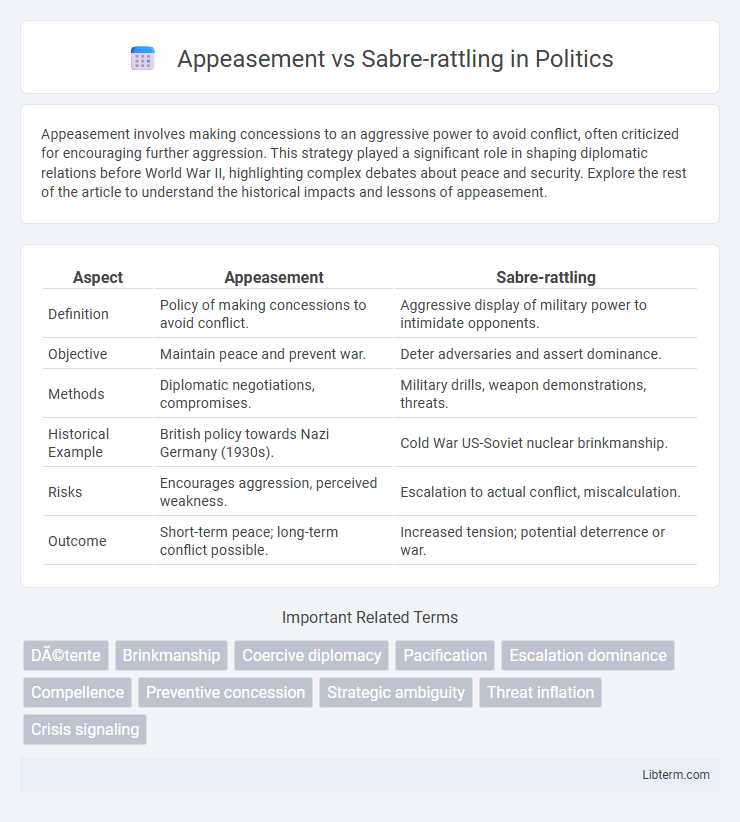Appeasement involves making concessions to an aggressive power to avoid conflict, often criticized for encouraging further aggression. This strategy played a significant role in shaping diplomatic relations before World War II, highlighting complex debates about peace and security. Explore the rest of the article to understand the historical impacts and lessons of appeasement.
Table of Comparison
| Aspect | Appeasement | Sabre-rattling |
|---|---|---|
| Definition | Policy of making concessions to avoid conflict. | Aggressive display of military power to intimidate opponents. |
| Objective | Maintain peace and prevent war. | Deter adversaries and assert dominance. |
| Methods | Diplomatic negotiations, compromises. | Military drills, weapon demonstrations, threats. |
| Historical Example | British policy towards Nazi Germany (1930s). | Cold War US-Soviet nuclear brinkmanship. |
| Risks | Encourages aggression, perceived weakness. | Escalation to actual conflict, miscalculation. |
| Outcome | Short-term peace; long-term conflict possible. | Increased tension; potential deterrence or war. |
Understanding Appeasement and Sabre-Rattling
Appeasement involves making concessions to an aggressive power to avoid conflict, often seen in diplomatic contexts where peace is prioritized over confrontation. Sabre-rattling refers to aggressive posturing or threats, typically by military forces, meant to intimidate an opponent without direct combat. Understanding the strategic motivations behind appeasement and sabre-rattling helps clarify their roles in international relations and conflict prevention.
Historical Origins and Evolution
Appeasement originated in the 1930s as a diplomatic policy used primarily by Britain and France to avoid conflict with aggressive powers like Nazi Germany by conceding to some demands. Sabre-rattling, rooted in military posturing tactics, has evolved from overt threats and displays of force intended to intimidate adversaries without engaging in direct conflict. Over time, appeasement has often been criticized for encouraging aggression, while sabre-rattling remains a common strategy for signaling strength and deterring potential threats.
Key Examples in 20th Century Diplomacy
Appeasement in 20th century diplomacy is epitomized by the 1938 Munich Agreement, where Britain and France conceded the Sudetenland to Nazi Germany to avoid war, ultimately emboldening Hitler's aggression. Sabre-rattling is illustrated by U.S. Cold War tactics such as the Cuban Missile Crisis, where the Kennedy administration leveraged aggressive military posturing to counter Soviet missile deployment in Cuba. Both strategies had significant impacts on international relations, influencing the dynamics of war and peace during critical historical junctures.
Psychological Drivers Behind Each Strategy
Appeasement appeals to psychological drivers such as fear of conflict, desire for security, and risk aversion, motivating states to avoid confrontation through concessions. Sabre-rattling involves psychological factors like signaling strength, deterrence through intimidation, and boosting national morale to project power and resolve. Understanding these contrasting motivations reveals how states manage threat perceptions and influence adversary behavior in international relations.
Effectiveness in Preventing Conflict
Appeasement often failed to prevent conflict as it was perceived as weakness, emboldening aggressive powers like Nazi Germany to pursue expansion. Sabre-rattling, by contrast, can sometimes deter adversaries through displays of military strength, but risks escalating tensions into full-scale conflict if misinterpreted. Historical evidence suggests that a balanced approach combining credible deterrence with diplomatic engagement tends to be more effective in maintaining peace.
Risks and Consequences of Appeasement
Appeasement often leads to increased aggression as it signals weakness, emboldening hostile powers to escalate demands or military actions, which can destabilize regional security. Historical evidence, such as the pre-World War II policy toward Nazi Germany, illustrates how appeasement can delay conflict but ultimately result in larger, more devastating wars. The risks of appeasement include undermining alliances and eroding deterrence capabilities, making future threats harder to contain.
Dangers and Outcomes of Sabre-Rattling
Sabre-rattling, characterized by aggressive military posturing and threats, often escalates tensions and increases the risk of unintended conflict, particularly in volatile geopolitical environments. This strategy can provoke adversaries, disrupt diplomatic negotiations, and lead to costly arms races, ultimately undermining regional and global stability. Historical cases, such as the Cold War arms buildup, demonstrate how sabre-rattling may result in prolonged hostility without achieving peaceful resolutions.
Modern-Day Applications in International Relations
Appeasement in modern international relations often involves diplomatic concessions to avoid conflict, as seen in efforts to engage North Korea through dialogue and economic incentives. Sabre-rattling manifests through military posturing, such as increased naval deployments in the South China Sea or aggressive rhetoric in cyber warfare domains, signaling strategic deterrence. Balancing these approaches remains crucial for managing tensions between global powers without escalating into open conflicts.
Case Studies: Successes and Failures
Appeasement, exemplified by the 1938 Munich Agreement, initially sought to prevent war by conceding to Nazi Germany's territorial demands but ultimately failed, emboldening further aggression and leading to World War II. In contrast, sabre-rattling tactics such as the Cuban Missile Crisis of 1962 successfully used military threats and strategic posturing to avoid nuclear conflict through negotiation and mutual restraint. The contrasting case studies highlight appeasement's risk of encouraging expansionism, while sabre-rattling can deter adversaries if combined with credible force and diplomatic channels.
Choosing the Right Approach in Today’s Geopolitics
Choosing between appeasement and sabre-rattling in today's geopolitics requires a nuanced understanding of regional power dynamics and historical conflict patterns. Appeasement may de-escalate tensions with rising powers like China, preventing unnecessary military conflict, while sabre-rattling can act as a deterrent against aggressive states such as North Korea by demonstrating military readiness. Effective strategy balances diplomatic engagement with credible defense postures to safeguard national interests and maintain global stability.
Appeasement Infographic

 libterm.com
libterm.com